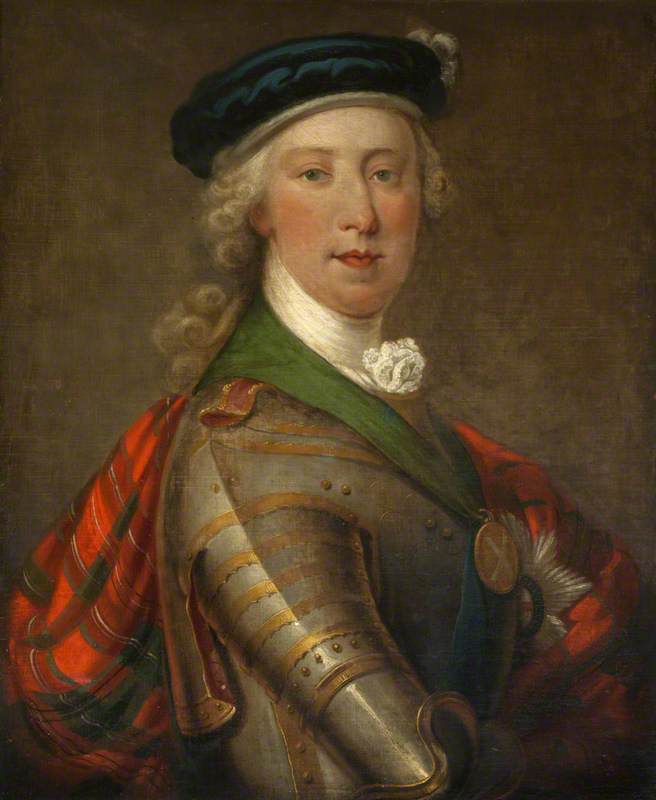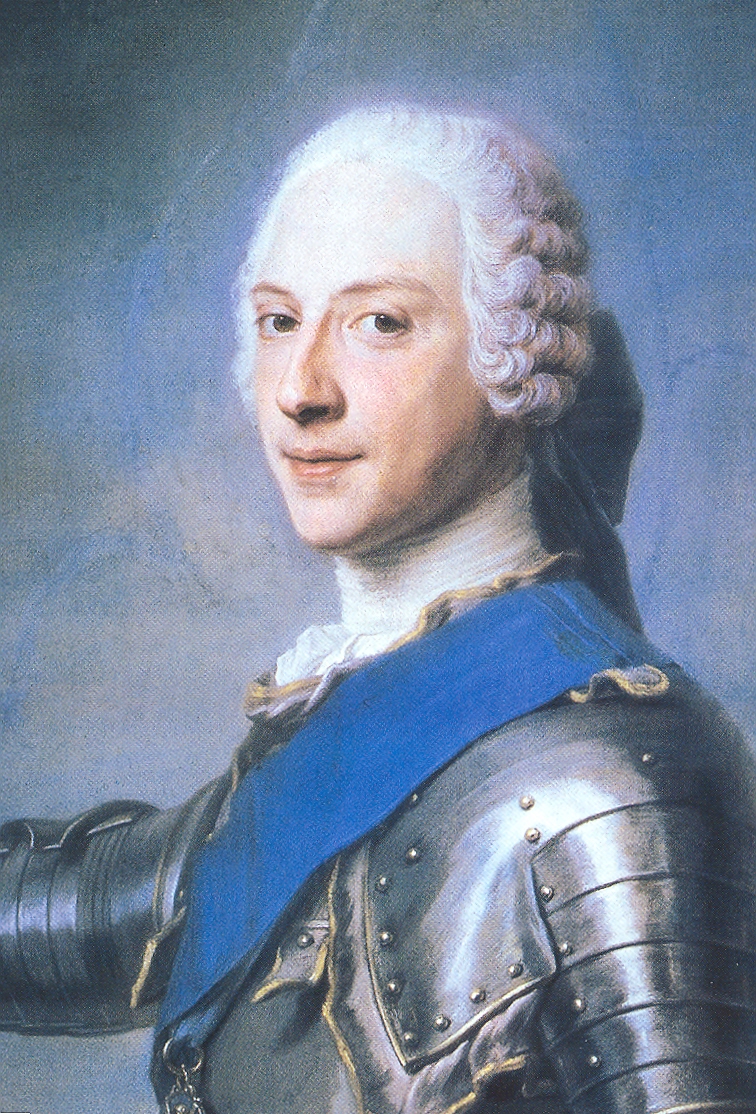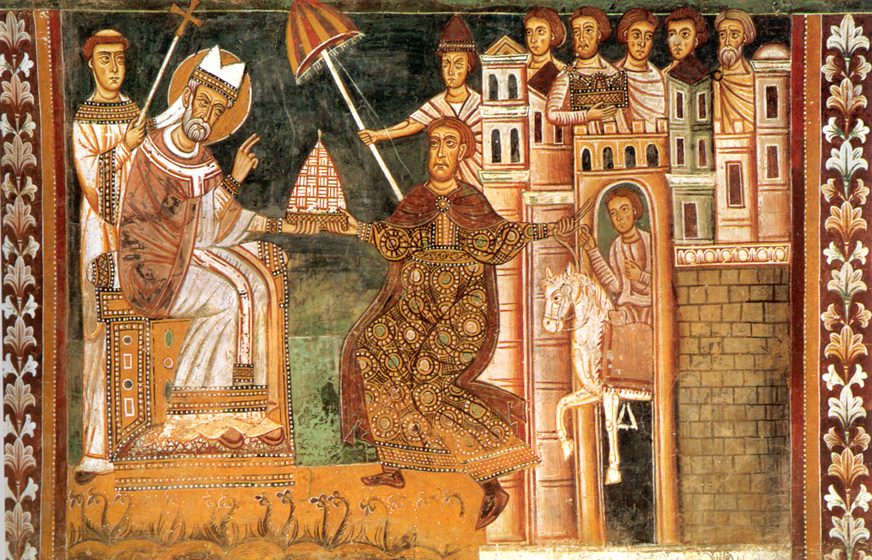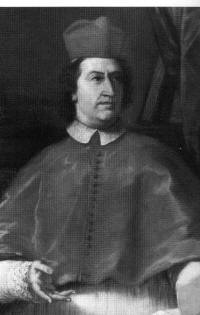|
Count Of Albany
Charles Edward Louis John Sylvester Maria Casimir Stuart (20 December 1720 – 30 January 1788) was the elder son of James Francis Edward Stuart, grandson of James II and VII, and the Stuart claimant to the thrones of England, Scotland and Ireland from 1766 as Charles III. During his lifetime, he was also known as "the Young Pretender" and "the Young Chevalier"; in popular memory, he is known as Bonnie Prince Charlie. Born in Rome to the exiled Stuart court, he spent much of his early and later life in Italy. In 1744, he travelled to France to take part in a planned invasion to restore the Stuart monarchy under his father. When the French fleet was partly wrecked by storms, Charles resolved to proceed to Scotland following discussion with leading Jacobites. This resulted in Charles landing by ship on the west coast of Scotland, leading to the Jacobite rising of 1745. The Jacobite forces under Charles initially achieved several victories in the field, including the Battle of ... [...More Info...] [...Related Items...] OR: [Wikipedia] [Google] [Baidu] |
Lost Portrait Of Charles Edward Stuart
The "lost portrait" of Charles Edward Stuart is a portrait, painted in late autumn 1745 by Scottish artist Allan Ramsay, of Charles Edward Stuart, also known as the Young Pretender or Bonnie Prince Charlie. The painting was discovered by art dealer and art historian Bendor Grosvenor at Gosford House, the home of the Earl of Wemyss near Edinburgh, and was authenticated by the Ramsay authority Duncan Thomson, former Director of the Scottish National Portrait Gallery, where the painting is now held. Background In 2009, Grosvenor revealed that the subject of the best-known portrait of Charles Edward Stuart, the pastel by the French artist Maurice Quentin de La Tour that had been hanging in the Scottish National Portrait Gallery since 1994, was in fact of Charles's younger brother Henry Benedict Stuart. This portrait had until then been widely reproduced and was "immortalised on countless tins of shortbread", as well as appearing in the entry for Charles in the ''Dictionary of Na ... [...More Info...] [...Related Items...] OR: [Wikipedia] [Google] [Baidu] |
Jacobite Rising Of 1745
The Jacobite rising of 1745, also known as the Forty-five Rebellion or simply the '45 ( gd, Bliadhna Theàrlaich, , ), was an attempt by Charles Edward Stuart to regain the Monarchy of Great Britain, British throne for his father, James Francis Edward Stuart. It took place during the War of the Austrian Succession, when the bulk of the British Army was fighting in mainland Europe, and proved to be the last in Jacobite risings, a series of revolts that began in Jacobite rising of 1689, 1689, with major outbreaks in 1708, Jacobite rising of 1715, 1715 and Jacobite rising of 1719, 1719. Charles launched the rebellion on 19 August 1745 at Glenfinnan in the Scottish Highlands, capturing Edinburgh and winning the Battle of Prestonpans in September. At a council in October, the Scots agreed to invade England after Charles assured them of substantial support from English Jacobitism, Jacobites and a simultaneous French landing in Southern England. On that basis, the Jacobite Army (1745) ... [...More Info...] [...Related Items...] OR: [Wikipedia] [Google] [Baidu] |
Dutch People
The Dutch (Dutch: ) are an ethnic group and nation native to the Netherlands. They share a common history and culture and speak the Dutch language. Dutch people and their descendants are found in migrant communities worldwide, notably in Aruba, Suriname, Guyana, Curaçao, Argentina, Brazil, Canada,Based on Statistics Canada, Canada 2001 Censusbr>Linkto Canadian statistics. Australia, South Africa, New Zealand and the United States.According tFactfinder.census.gov The Low Countries were situated around the border of France and the Holy Roman Empire, forming a part of their respective peripheries and the various territories of which they consisted had become virtually autonomous by the 13th century. Under the Habsburgs, the Netherlands were organised into a single administrative unit, and in the 16th and 17th centuries the Northern Netherlands gained independence from Spain as the Dutch Republic. The high degree of urbanization characteristic of Dutch society was attained at a ... [...More Info...] [...Related Items...] OR: [Wikipedia] [Google] [Baidu] |
John III Sobieski
John III Sobieski ( pl, Jan III Sobieski; lt, Jonas III Sobieskis; la, Ioannes III Sobiscius; 17 August 1629 – 17 June 1696) was King of Poland and Grand Duke of Lithuania from 1674 until his death in 1696. Born into Polish nobility, Sobieski was educated at the Jagiellonian University and toured Europe in his youth. As a soldier and later commander, he fought in the Khmelnytsky Uprising, the Russo-Polish War and during the Swedish invasion known as the Deluge. Sobieski demonstrated his military prowess during the war against the Ottoman Empire and established himself as a leading figure in Poland and Lithuania. In 1674, he was elected monarch of the Polish–Lithuanian Commonwealth following the sudden and unexpected death of King Michael. Sobieski's 22-year reign marked a period of the Commonwealth's stabilization, much needed after the turmoil of previous conflicts. Popular among his subjects, he was an able military leader, most famous for his victory over the Turks ... [...More Info...] [...Related Items...] OR: [Wikipedia] [Google] [Baidu] |
Saint Sylvester's Day
Saint Sylvester's Day, also known as Silvester or the Feast of Saint Sylvester, is the day of the feast of Pope Sylvester I, a saint who served as Pope from 314 to 335. Medieval legend made him responsible for the conversion of emperor Constantine. Among the Western churches, the feast day is held on the anniversary of Saint Sylvester's death, 31 December, a date that, since the adoption of the Gregorian calendar, has coincided with New Year's Eve. For these Christian denominations, Saint Silvester's Day liturgically marks the seventh day of Christmastide. Eastern churches celebrate Sylvester's feast on a different day from the Western churches, i.e. on 2 January. Saint Sylvester's Day celebrations are marked by church attendance at Midnight Mass or a Watchnight service, as well as fireworks, partying, and feasting. Pope Sylvester I Under the reign of Pope Sylvester I, several of the magnificent Christian churches were built, including the Basilica of Saint John Lateran, Sa ... [...More Info...] [...Related Items...] OR: [Wikipedia] [Google] [Baidu] |
Edward The Confessor
Edward the Confessor ; la, Eduardus Confessor , ; ( 1003 – 5 January 1066) was one of the last Anglo-Saxon English kings. Usually considered the last king of the House of Wessex, he ruled from 1042 to 1066. Edward was the son of Æthelred the Unready and Emma of Normandy. He succeeded Cnut the Great's son – and his own half-brother – Harthacnut. He restored the rule of the House of Wessex after the period of Danish rule since Cnut conquered England in 1016. When Edward died in 1066, he was succeeded by his wife's brother Harold Godwinson, who was defeated and killed in the same year by the Normans under William the Conqueror at the Battle of Hastings. Edward's young great-nephew Edgar the Ætheling of the House of Wessex was proclaimed king after the Battle of Hastings in 1066 but was never crowned and was peacefully deposed after about eight weeks. Historians disagree about Edward's fairly long 24-year reign. His nickname reflects the traditional image ... [...More Info...] [...Related Items...] OR: [Wikipedia] [Google] [Baidu] |
Charles I Of England
Charles I (19 November 1600 – 30 January 1649) was King of England, Scotland, and Ireland from 27 March 1625 until Execution of Charles I, his execution in 1649. He was born into the House of Stuart as the second son of King James VI of Scotland, but after his father inherited the English throne in 1603, he moved to England, where he spent much of the rest of his life. He became heir apparent to the kingdoms of England, Scotland, and Ireland in 1612 upon the death of his elder brother, Henry Frederick, Prince of Wales. An unsuccessful and unpopular attempt to marry him to the Spanish Habsburg princess Maria Anna of Spain, Maria Anna culminated in an eight-month visit to Spain in 1623 that demonstrated the futility of the marriage negotiation. Two years later, he married the House of Bourbon, Bourbon princess Henrietta Maria of France. After his 1625 succession, Charles quarrelled with the Parliament of England, English Parliament, which sought to curb his royal prerogati ... [...More Info...] [...Related Items...] OR: [Wikipedia] [Google] [Baidu] |
Roman Catholic Diocese Of Montefiascone
The diocese of Montefiascone (''Latin Name: Faliscodunensis o Montis Falisci'') was a Catholic ecclesiastical territory in Italy. It was created from the diocese of Bagnorea in 1369. In 1986 was united into the diocese of Viterbo, Acquapendente, Bagnoregio, Montefiascone, Tuscania e San Martino al Monte Cimino."Diocese of Montefiascone" ''''. David M. Cheney. Retrieved February 29, 2016."Titular Episcopal See of Montefiascone" ''GCatholic.org''. Gabriel Chow. Retrieved Febr ... [...More Info...] [...Related Items...] OR: [Wikipedia] [Google] [Baidu] |
Pope Clement XI
Pope Clement XI ( la, Clemens XI; it, Clemente XI; 23 July 1649 – 19 March 1721), born Giovanni Francesco Albani, was head of the Catholic Church and ruler of the Papal States from 23 November 1700 to his death in March 1721. Clement XI was a patron of the arts and of science. He was also a great benefactor of the Vatican Library; his interest in archaeology is credited with saving much of Rome's antiquity. He authorized expeditions which succeeded in rediscovering various ancient Christian writings and authorized excavations of the Roman catacombs. Biography Early life Giovanni Francesco Albani was born in 1649 in Urbino to the Albani family, a distinguished family of Albanian origin in central Italy. His mother Elena Mosca (1630-1698) was a high-standing Italian of bergamasque origin, descended from the noble Mosca family of Pesaro. His father Carlo Albani (1623-1684) was a patrician. His mother descended in part from the Staccoli family, who were patricians of Urbino, ... [...More Info...] [...Related Items...] OR: [Wikipedia] [Google] [Baidu] |
Rome
, established_title = Founded , established_date = 753 BC , founder = King Romulus (legendary) , image_map = Map of comune of Rome (metropolitan city of Capital Rome, region Lazio, Italy).svg , map_caption = The territory of the ''comune'' (''Roma Capitale'', in red) inside the Metropolitan City of Rome (''Città Metropolitana di Roma'', in yellow). The white spot in the centre is Vatican City. , pushpin_map = Italy#Europe , pushpin_map_caption = Location within Italy##Location within Europe , pushpin_relief = yes , coordinates = , coor_pinpoint = , subdivision_type = Country , subdivision_name = Italy , subdivision_type2 = Region , subdivision_name2 = Lazio , subdivision_type3 = Metropolitan city , subdivision_name3 = Rome Capital , government_footnotes= , government_type = Strong Mayor–Council , leader_title2 = Legislature , leader_name2 = Capitoline Assemb ... [...More Info...] [...Related Items...] OR: [Wikipedia] [Google] [Baidu] |
Treaty Of Aix-la-Chapelle (1748)
The 1748 Treaty of Aix-la-Chapelle, sometimes called the Treaty of Aachen, ended the War of the Austrian Succession, following a congress assembled on 24 April 1748 at the Free Imperial City of Aachen. The two main antagonists in the war, Britain and France, opened peace talks in the Dutch city of Breda in 1746. Agreement was delayed by British hopes of improving their position; when this failed to occur, a draft treaty was agreed on 30 April 1748. A final version was signed on 18 October 1748 by Britain, France, and the Dutch Republic. The terms were then presented to the other belligerents, who could either accept them or continue the war on their own. Austria, Spain, and Sardinia had little choice but to comply, and signed separately. Modena and Genoa joined together on 21 January 1749. The treaty largely failed to resolve the issues that caused the war, while most of the signatories were unhappy with the terms. Maria Theresa resented Austria's exclusion from the talks, ... [...More Info...] [...Related Items...] OR: [Wikipedia] [Google] [Baidu] |








